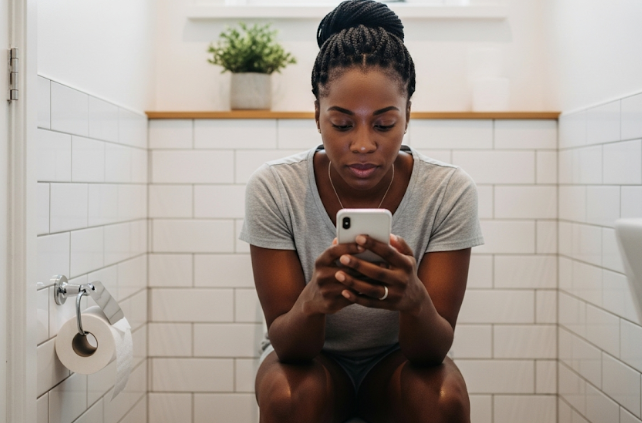Bathroom Scrolls Are Risky: How Your Phone Could Be Giving You Piles
- Christabel Adhiambo

- 13 hours ago
- 3 min read

It is a familiar scene in households, offices or even cafes, a person slips into the bathroom, smartphone in hand, scrolling through social media, catching up on the latest news, or replying to messages.
What is supposed to be a brief, private moment of relief often stretches into several minutes of uninterrupted screen time.
While it may feel harmless or even productive, scientists are now raising alarms about this modern habit, linking it to an increased risk of developing haemorrhoids, also known as piles.
A recent study from Beth Israel Deaconess Medical Centre in the United States found that adults who used smartphones while on the toilet had a 46 per cent higher likelihood of developing haemorrhoids compared to those who did not bring devices into the bathroom.
The research involved 125 adults undergoing routine bowel cancer screening, who completed detailed surveys about their toilet habits and lifestyle. Doctors then assessed the participants for signs of haemorrhoids.
The study revealed that two-thirds of participants admitted to using smartphones while on the toilet, with younger adults most likely to engage in this behavior.
Time spent on the toilet was markedly higher among phone users: 37 per cent spent more than five minutes per visit, compared to just 7 per cent of non-users.
Popular activities included scrolling through social media feeds, reading news articles, checking emails, texting, watching videos, or even playing mobile games.
“I know it’s not ideal, but even when I use public toilets in Kibera, I bring my phone,” said 21-year-old Molly Achieng’.
“It helps me catch up on messages and read articles with the time that would have been spent doing nothing, so it feels productive.”
Despite her awareness of the risks, she admits it can sometimes stretch her bathroom time longer than intended.
Haemorrhoids develop when the veins in and around the anus and lower rectum become swollen and inflamed.
Symptoms may include itching, pain, bleeding after bowel movements, lumps near the anus, and general discomfort.
Common risk factors traditionally include straining during bowel movements, chronic constipation and low-fiber diets.
Interestingly, the study noted that straining itself was not significantly linked to haemorrhoids among participants, highlighting that prolonged sitting, especially when distracted by smartphones, may be a key contributor.
“I know most of my children prefer using their phones in the toilet, and it takes them so long,” said 45-year-old James Maina from Rongai.
“I have tried advising them otherwise, but it doesn’t work and honestly, it annoys me.”
His observation mirrors the study’s findings that younger adults are more likely to engage in this behavior.
Experts advise simple, practical steps to reduce the risk. Eating a fiber-rich diet, drinking plenty of water, avoiding extended toilet sessions and maintaining regular physical activity can all help.
Beyond the medical findings, the study emphasises a broader social trend; the pervasiveness of mobile devices has extended into every aspect of daily life, even moments once reserved for privacy and quick relief.
While phones make it easy to stay connected, experts warn that these small, seemingly harmless habits can have unexpected health consequences.
For those who find themselves scrolling while sitting on the toilet, the message is clear, put the phone down, take a few minutes to let your body do its work, and save your veins from unnecessary strain.





Comments